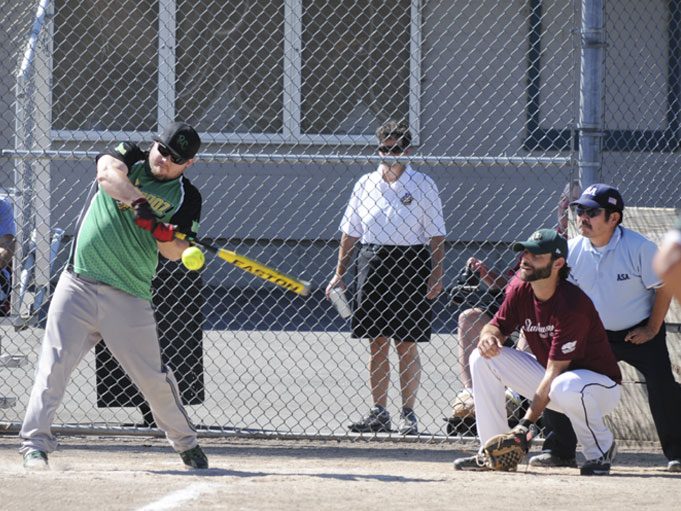One topic that garners a lot of discussion among baseball umpires is whether or not you should describe pitches for pitchers. That discussion also depends a great deal on the level of competition. Obviously, there are pros and cons to the practice. It often depends on the umpire’s personality and how he or she approaches plate work.
But what about slow-pitch softball? Especially, the average league play softball pitcher? At any level of play in baseball, fast-pitch softball and slow-pitch softball, you want pitchers pitching strikes. That is the nirvana of a great game. In lower levels, you might have only one pitcher who can throw strikes. If the coach has to take the first pitcher out of the game, it is probably going to be a long game. The result may be the same for an adult slow-pitch game as well. Not only do you not want to call ball after ball, but the batters expect to hit! That is the essence of slow-pitch softball — hitting the ball, running the bases, scoring runs, defensive players catching fly balls and infielders making plays.
So how does a slow-pitch softball umpire help the pitcher pitch strikes?
Communicate
When the pitch doesn’t reach the plate and the ball bounces in the dirt, it is going to be called a ball. There is not much you can do to coax a strike out of that kind of pitch.
However, when the pitches are crossing the plate and when they are very close to crossing the plate, there are ways to let the pitcher know how close the pitch was to being a strike. The techniques that you use can garner many strikes during the course of a slow-pitch game.
One of the most detrimental things an umpire can do when calling balls and strikes is not communicating why the pitch is not a strike. Some umpires simply shake their head from side to side denoting the pitch isn’t a strike. As a pitcher, this would be very frustrating. After a while the pitcher usually gets frustrated enough that he finally asks, “Where’s the pitch?” and then the umpire explains what is wrong. With better communication, the umpire could have been coaxing strikes.
How to coax a strike
Most often when the pitch crosses the plate and it isn’t a strike, it is because it is out of the strike zone to the rear. Some umpires call this pitch “deep.” When the pitch is extreme to the rear, not a lot needs to be said except simply calling it a ball. It is when the pitches are just a bit out of the strike zone at the back where the coaching and coaxing can be most effective. I simply say, “too far back” when it is fairly obvious and “just a bit back” when it looks like a strike, but just didn’t quite make it as a strike. I also place the palm of my hand on my chest as a visual indicator. When you tell the pitcher that he just barely missed pitching a strike, it gives him encouragement that he can fine tune the next pitch and get that strike.
When the ball is coming in and just misses the inside or outside of the plate, I usually say, “It just drifted in a bit,” or, “It just drifted out a bit.” Again, you are letting the pitcher know that he is very close to pitching a strike. When the pitch is far enough inside that the batter has to move and far enough outside that the catcher has to move, the pitch speaks for itself.
Coaching the flat pitches and the high pitches can be done where the pitcher doesn’t “lose a pitch.” Here is the process. When you have the opportunity to let the pitcher know that the pitch was too high (more than 10 feet or 12 feet, depending on the association) and when the pitch doesn’t meet the minimum arc, you can do it when the pitch doesn’t meet another criteria to be a strike. Let’s say the pitch is obviously outside. And at the same time, when the pitch is too high, you have the opportunity to call the pitch too high which signals the pitcher to throw the pitch lower. So, he basically has a free reminder that you aren’t going to call a pitch that high a strike. This also works well when the pitcher hasn’t broken the height limit but is right at it a lot of the time.
The same technique works for the flat pitch. If it is obviously outside or inside, call the pitch flat and again the pitcher gets the message that you won’t call that pitch a strike because it doesn’t meet the minimum arc.
In slow-pitch softball, strikes enable the batter to hit, the fielders to play and the game to be active. Help the pitcher pitch more strikes by encouraging him and explaining just how close that pitch was to being a strike.
What's Your Call? Leave a Comment:
Note: This article is archival in nature. Rules, interpretations, mechanics, philosophies and other information may or may not be correct for the current year.
This article is the copyright of ©Referee Enterprises, Inc., and may not be republished in whole or in part online, in print or in any capacity without expressed written permission from Referee. The article is made available for educational use by individuals.


















